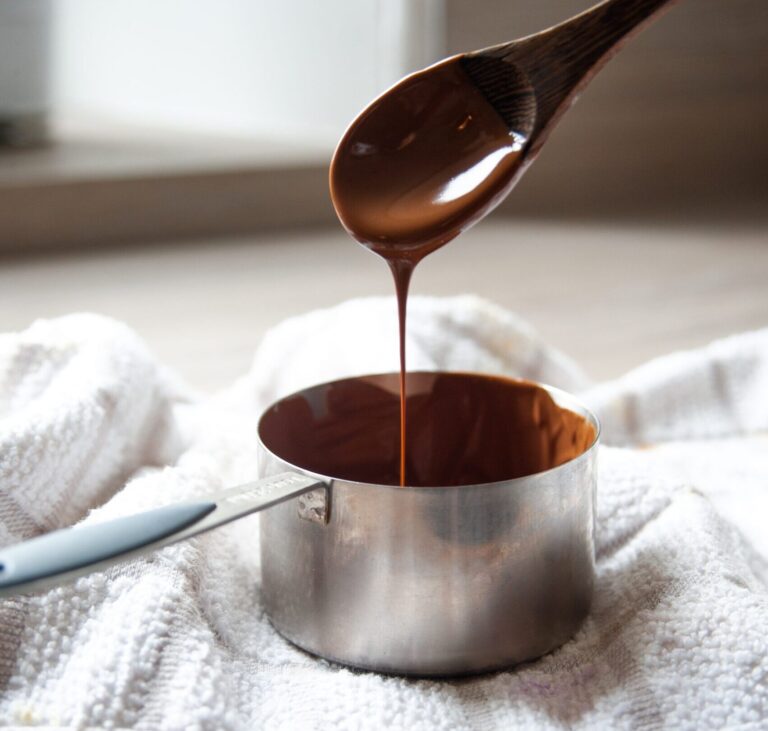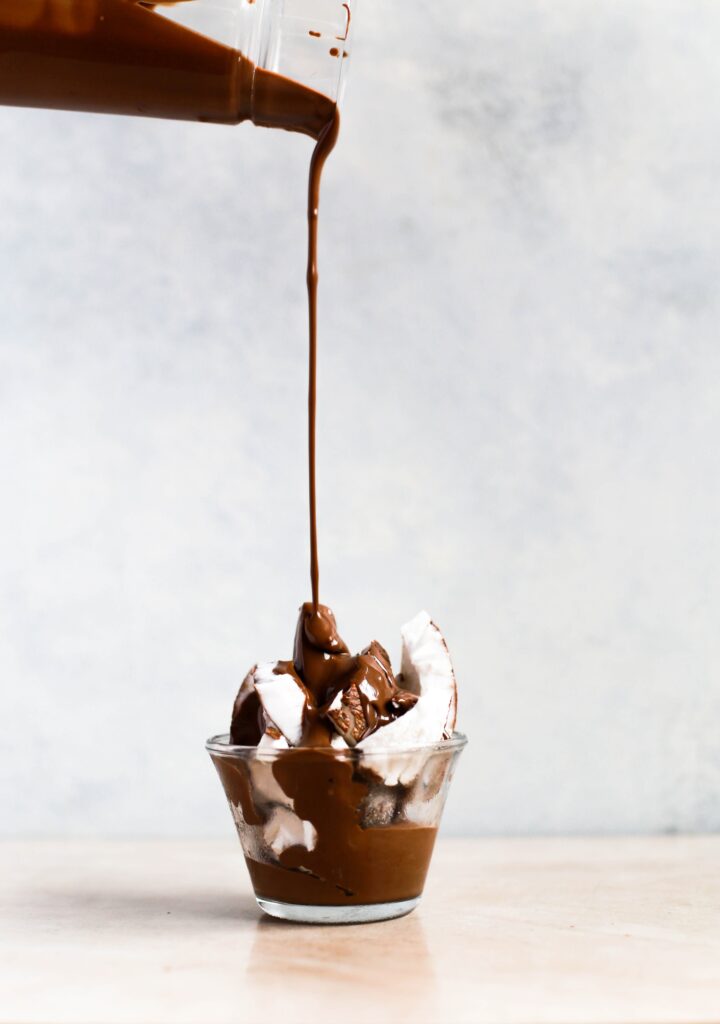Melting and Tempering: A Guide to Temperatures
Posted: 26 Jun 2023
Melting
To understand how to melt your chocolate, it is helpful to first review the different types of crystal that can occur in chocolate. The fats in cocoa butter can form six different types of crystal, which melt at different temperatures:
Crystal type | Melting point | Taste notes |
Type I | 17.3°C | Soft, crumbly |
Type II | 23.3°C | Crumbly, melts easily |
Type III | 25.5°C | Firm but melts easily |
Type IV | 27.3°C | Firmer but melts easily |
Type V | 33.8°C | Best for eating: melts near body temperature, crisp snap |
Type VI | 36.3°C | Soft, waxy texture, forms from the type V crystal |
Ideal Melting Temperatures
- Dark: 45 – 50°c
- Milk / White: 40 – 45°c
How to Melt Your Chocolate
You can melt it in a:
- microwave;
- continuous tempering machine (e.g. Keychoc Infinity AX / BX);
- batch temperer (Keychoc Infinity MX / BT150); or
- melting tank (Keychoc Infinity MT Series).
Top Tip for Melting Your Chocolate
Take your chocolate up to the required temperature, stir it and hold it for 12 hours at this temperature. This is the best way to ensure you fully decrystallise your chocolate, in particular the more thermodynamically stable, type VI crystals. Fully decrystallising your chocolate means that when you temper it, there is a better chance of having only type V crystals present, which is the ideal result. Melting your chocolate at a higher temperature for longer is especially important if your chocolate is a dark chocolate with a high cocoa solids content, or if your chocolate has been melted and tempered several times already.
If this is impractical for you, it is still okay to melt your chocolate and then temper it immediately. Your chocolate will still be well tempered but it may have a tendency to thicken up slightly more quickly. The reason for this is that there may still be some type VI crystal present in your tempered chocolate.


Tempering
Establishing the “right” tempering temperature for your chocolate is not a precise science but will depend on a number of different factors. The important thing is not the exact temperature, but whether your chocolate is properly tempered and workable at that temperature.
Recommended Temperatures on the Bag
These should NOT be followed rigidly as they are only a guide, often calibrated for slab tempering. The appropriate working temperature for your chocolate will vary according to any or all of the following:
- Your tempering method
- The brand of your continuous tempering machine (if you’re using one)
- Your environmental conditions (temperature, humidity and airflow)
- Your intended application (moulding or enrobing)
How to Temper Your Chocolate
You can temper/hold your chocolate in/on a:
- Marble slab (temper only);
- Microwave (temper only);
- Table-top melting tank (eg. Martellato Digital Meltinchoc Series);
- Continuous tempering machine (Keychoc Infinity AX / BX); or
- Batch tempering machine (Keychoc Infinity MX / BT150).
After tempering on a slab or in a microwave, if you hold the tempered chocolate in a bowl you will need to periodically warm it with a heat gun to prevent it from thickening up. Keeping the bowl on an insulated mat may help to retain heat. You should also try to keep the sides of the bowl clean.
If you are holding the tempered chocolate in a bowl or table-top melter, you will also need to regularly stir the chocolate to evenly spread the heat and prevent a ‘skin’ from forming.
If you temper in a continuous or batch tempering machine, your chocolate temperature will be maintained automatically and your chocolate will be continuously stirred. This will typically allow you to keep your chocolate perfectly tempered for a full 8 hour day without the worry of your chocolate accidentally going off temper.
Top Tips for Storing Tempered Chocolate
The type V crystal in perfectly tempered chocolate will gradually convert into type VI at room temperature, potentially reducing the shelf life of dark chocolate to a few months. This is why chocolate should be stored at 15-18°c, to prevent this conversion. The addition of milk fat in milk and white chocolate slows this conversion.
General Guide
Microwave tempering
Melting |
In a microwave, the aim is to slowly melt your chocolate so that it never decrystallises. Since your chips/callets are usually pre-tempered, you already have a seed and you don’t want to allow it to melt.
|
Typical temperatures D: 45-50°c M: 40-45°c W: 40-45°c |
Cooling |
There is no cooling phase when microwave tempering.
|
Working |
This will be the appropriate working temperature for your chocolate, environment and application.
|
Typical temperatures D: 31-32°c M: 30-31°c W: 28-29°c |
Seed tempering
(e.g. Keychoc Infinity MX, wheel machine, Martellato table-top melter)
Melting |
The objective here is to fully decrystallise your chocolate by melting to the appropriate temperature. |
Typical temperatures D: 45-50°c M: 40-45°c W: 40-45°c |
Cooling |
Adding seed (unmelted pre-tempered chocolate) serves to cool and crystallise your chocolate. The goal is to add the appropriate % of seed to exactly bring your chocolate down to the desired working temperature.
|
Working |
You should already be at your desired working temperature and fluidity at the end of the cooling phase when seed tempering.
|
Typical temperatures D: 31-33°c M: 30-32°c W: 28-30°c |
Continuous tempering
(e.g. Keychoc Infinity AX / BX, Selmi, FBM, Pomati, etc.)
Melting |
The objective here is to fully de-crystallise your chocolate by melting to the appropriate temperature.
|
Typical temperatures D: 45-50°c M: 40-45°c W: 40-45°c |
Cooling |
Continuous tempering machines are designed to rapidly and automatically cool the chocolate to create seed.
|
Typical temperatures D: 31-33°c M: 30-32°c W: 28-30°c |
Working |
At the end of the tempering cycle, the machine will automatically bring the chocolate to the set working temperature and maintain it.
|
Troubleshooting
Problem | Solution |
| Your chocolate is thickening up in the bowl after microwave tempering. | 1. Make sure you regularly stir the tempered chocolate and heat the top surface of the chocolate with a heat gun (at least every 20 minutes or so). 2. If it is still thickening up, heat it for 10 seconds in the microwave and then stir thoroughly. Repeat if necessary, but ensure you don’t let the chocolate go above 33⁰c, otherwise it might fully decrystallise.
|
| Your chocolate is thickening up in your table-top melting tank. | 1. Make sure you are stirring the tempered chocolate at least every 20 minutes or so. 2. Also ensure there are no cold draughts that could be causing your chocolate to form a skin. 3. If necessary, warm up your chocolate using a heat gun and stir well. 4. It may also be necessary to increase the set temperature by 0.5-1.0°c (without going above 33°c).
|
| Your chocolate is under-tempered (slow to set, poor retraction from moulds) after seed tempering. | 1. You could allow your chocolate to cool a little in order to encourage further crystallisation. Once it starts to thicken, reset the working temperature. 2. Alternatively, you could heat the chocolate up to 36-37°c and add a little more seed, remembering to reset your working temperature. If you add seed below this temperature, there is a risk that it won’t melt. 3. Lastly, you could re-melt your chocolate up to 42-45°c and re-temper it, this time adding a slightly higher % of seed.
|
| Your chocolate is over-tempered (very thick) after seed tempering. | Warm up your chocolate by 0.2-0.5°c using a heat gun (for bowl or melter) or by increasing the set point. Repeat if necessary, but ensure you don’t let the chocolate go above 33°c.
|
| Your chocolate is thickening up in a continuous temperer. | Increase the working temperature set point by 0.2-0.5°c. Increase further if necessary, but ensure you don’t let the chocolate go above 33°c.
|
Take a look at our other Beginners Guides in the Resources hub for more on tempering and chocolate, or for all of our instructional modules, get the ‘Working with Chocolate’ DVD, created by Keylink Ltd.
.svg)
 white.svg)